An Interview with Keith Ruhl, Solid Waste Specialist (aka DEP’s Northcentral “Garbage Man”)
Have you ever seen a mess that seemed insurmountable? No, we’re not talking about your teenager’s bedroom. How about a mass dumping ground full of every imaginable form of waste, scattered across the landscape and tangled under vegetation along a steep slope in an inaccessible area? Illegal dumpsites are still an all-too-common scourge on Pennsylvania’s landscape, and cleaning them up can be an incredibly daunting challenge.
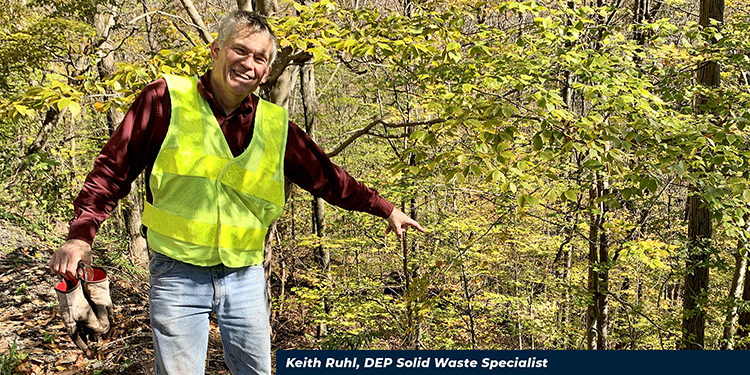
Keith Ruhl, a solid waste specialist in DEP’s Northcentral Regional Office (who jokingly calls himself a “garbage man”), has worked with community organizations in Pennsylvania’s rural Northern Tier to pioneer a successful template for cleaning up large illegal dumpsites.
When did you start doing illegal dumpsite cleanups, and how did it get started?
About five years ago, a representative from the non-profit organization Keep PA Beautiful visited our regional office to make our Waste Management Program staff aware of the illegal dumpsite surveys their organization conducted for the counties in our region. We started reviewing those survey reports and began growing a network of like-minded individuals and organizations that we thought might want to help.
Who are the partners and what is the process in identifying a dumpsite to clean up, typically?
County Conservation Districts, municipal and county governments, solid waste authorities, local companies, and non-profit organizations, such as watershed groups, are all excellent potential partners. In Tioga County, we have a “live wire” Conservation District Manager named Erica Tomlinson who is very passionate and driven to do these projects, for example. There are a lot of good folks out there, and you just have to make the connections to find them. One person is excited about doing something, and they know other people, and one thing leads to another; and pretty soon, you have a critical mass of help to pull it off!
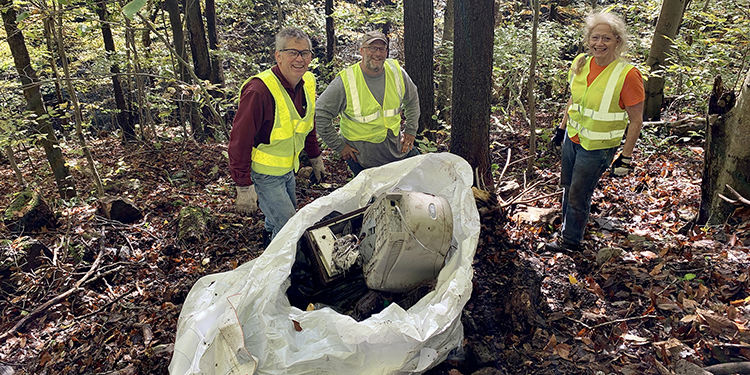
For our first cleanup in Deerfield Township, the dumpsite was in the county dumpsite survey book, but I had actually stopped at that site before I even knew about the book. I had looked over the edge and seen the nasty mess over the bank. So I thought that would be a good one to start with. I got in touch with Erica and Tioga County Planning, who I had worked with on waste issues in the past, and Tioga County Emergency Management Agency. One thing grew into another, and we scheduled some introductory meetings with neighbors in the community and planned out the project with the partners who committed to it. After about six months of laying the groundwork, that first cleanup took place.
Can you describe what the private sector role has been in the cleanups?
Many private companies and industries have a community service program, and they often have the people and machines needed to help pull something like this off. It’s a matter of contacting their community services person, explaining the cleanup concept, and asking if they have any resources to contribute. Many have been more than happy to jump right in by donating people and equipment. That really makes it happen, because these resources allow us to pick big loads up from steep banks and haul waste from places where nobody could do it by hand, such as up a 200-foot bank out of a gully. So you really need the heavy equipment to make it happen. And they’re anxious to do these projects because it reflects on their dedication to the community.
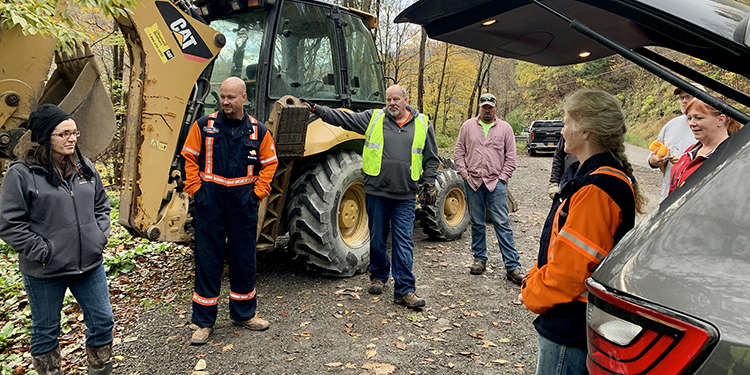
On a cleanup day, could you describe what the typical process entails?
Prior to the day of the event, we arrange for a roll off container (dumpster) to be delivered to the site and for disposal services, which are typically donated by a local landfill or solid waste organization at no cost. When the volunteers arrive at the event, we have a safety meeting to go over the roles of how we’re going to do the project. We hand out safety equipment and discuss safety rules to make sure nobody comes home with any cuts or damage. Then we all grab black contractor-grade trash bags, scramble down the bank, spread out, and start picking up waste. When a bag is full, we dump it into a supersack, which is a large woven polyethylene fabric bag, a very tough material with handles woven right onto the bag. We can attach a rope through those handles and drag the bag up the slippery slope using a truck or machine parked at the top. It’s really easy and works really well. Then we dump the supersacks out in the roll off container using a backhoe. Generally, the supersacks make it up the hill several times before they’re really destroyed enough that you can’t use them anymore. Sometimes, we use the same process to haul large items, such as mattresses or appliances, up the slope individually. We repeat this process as many times as needed until it’s done.
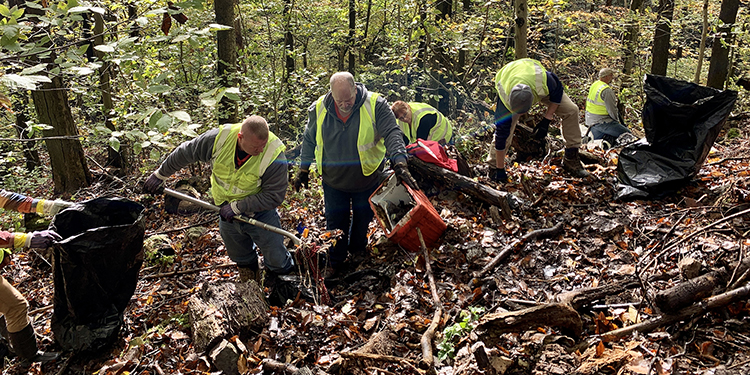
Can you describe some of the larger and odder materials you’ve found in these dumpsites?
We find appliances, vacuum cleaners, toasters, once in a while a dehumidifier or an electric heater. Old televisions are a problem because you often have to pay a disposal fee to get rid of a television at an authorized disposal that accepts electronics, and a lot of people won’t pay that, so they take it over and throw it down over the bank on the nearest country road, and that’s the end of it. We always find lots of tires; they’re another big disposal issue, cost-wise, for persons to get rid of. Another frequent thing we find is deer carcasses.
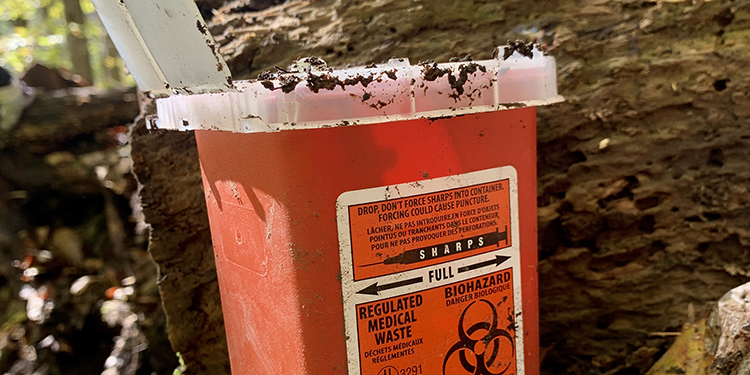
On our most recent dumpsite cleanup, we found a cache of probably 100 syringes and needles, possibly from a diabetic patient, based on the packaging. You always find a mix of household waste and some demolition waste and building parts. Some items are truly unusual and interesting. Some tell a story. We always compare notes on the oddest items we find.
One thing you don’t find as much are items that have value when taken to a scrapyard. If someone can get a nickel out of it for scrap metal, usually it won’t go over the bank.
These sites are not usually the result of the landowner dumping on their own property or a single person dumping, right?
Exactly. It’s usually in a remote section of the country on a steep hill with a pull-off along the road where the public can easily pull off the road and in a few seconds, throw their stuff over the bank and drive away undetected. And once it gets started, it attracts others. Very rarely will you find clues to ownership in the garbage, but once in a while, people will leave addresses or mail or something in the garbage that allow us to trace it back to who dumped it. Often the property owners are absent (living elsewhere) or not attentive to what’s going on, and that’s another contributing factor. Of course, we need the landowner’s permission to conduct a cleanup on the property.
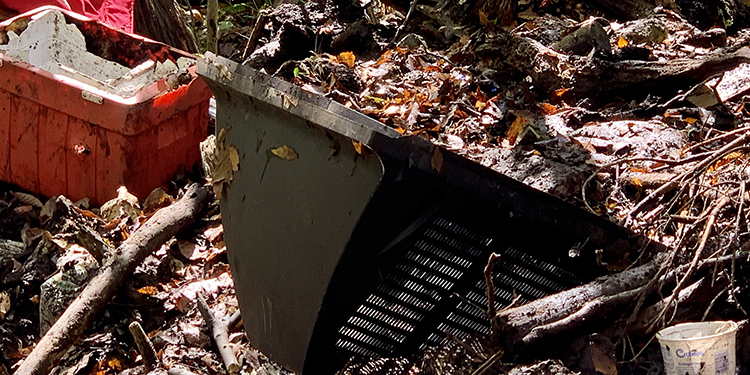
What advice do you have for someone who wants to tackle a project like this and clean up a large, complicated, and persistent community dumpsite? And how do you keep them from dumping again as soon as you clean it up?
First, get involved with like-minded individuals, such as your Conservation District, a watershed association or other community volunteers, maybe your township supervisors. It’s just building a web of interested people in the community. If you can, get involved in some kind of club that wants to do this kind of work and get a synergy going between a number of different people. Every place is going to be a little bit different, but I think Conservation Districts are a good place to start and see if they have any interest. There may be other entities in the communities that are focused on “adopting” specific locations they enjoy using for outdoor recreation.
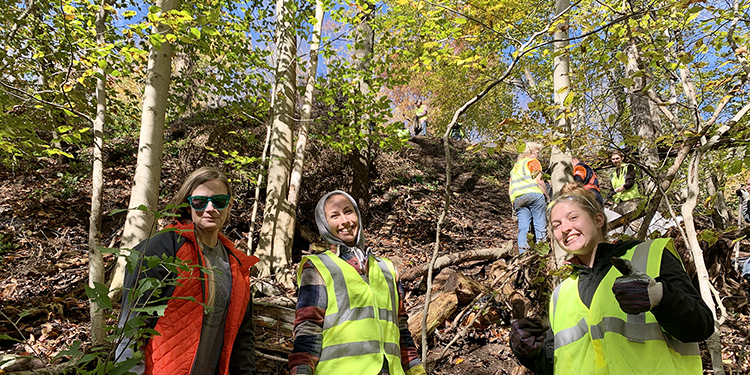
To prevent recurrence and secure the site is a difficult thing. A couple of things have been done in the past. At the Deerfield Twp. project in 2018, PennDOT came in after the cleanup and walled off the whole pull-off area with a guardrail so nobody can stop there anymore. If you can’t pull off the road, you can’t dump; that’s a big deterrent right there. We also usually try to post signs after a community cleanup that say “No Dumping: Community Cleanup Area,” but that’s not always effective for the people who are going to dump anyway. If it’s a persistent problem, somebody can even get cameras through Keep PA Beautiful to surveil the situation.
It’s very difficult to prevent it and stop it forever, but usually, a pile of trash begets more trash. So if somebody pulls over and doesn’t see anything, they might think twice about throwing their stuff down there. But if there’s already a big dump, they don’t think anything of it. Over it goes, they’re out of there, they’re done. They’re usually in very remote areas where nobody is there, not a lot of traffic, so it’s easy to get away with. And that’s why these things happen. So creating some sense that the site is being watched may help.
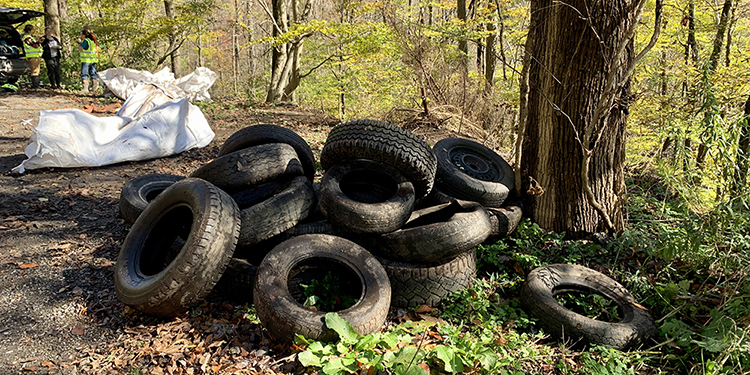
What is the satisfaction you get at the end of the projects?
Well, you get an impressive before and after picture, of course! It’s satisfying that you’ve actually accomplished something. You’ve taken garbage away from the potential of polluting a nearby waterway, which is also good, because a lot of these sites are right above or next to a stream or creek. And you also have the camaraderie of all the individuals who work together. Once people get cleaning up, it’s pretty fun. You’re not just picking up trash, you get to hobnob with like-minded people who want to make the place better and leave it better than they found it. And you do a good thing for the community too. It’s a good project all around!
Keep PA Beautiful registers these events and keeps track of them. So you can always call them for assistance, they’ll give you moral support, gloves and bags, whatever they can supply. There’s a lot of reward in doing a project like this. I encourage anyone with any interest in getting involved to find those folks in your community that really are interested and passionate, and find the resources and you can make it happen.
Note: DEP congratulates Keith Ruhl, featured in this blog post, on his recent retirement. We look forward to seeing Keith as a volunteer at future litter pickup and dumpsite cleanup events!